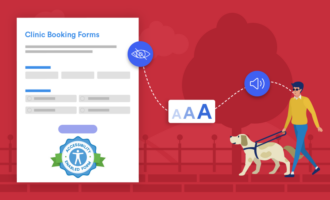Section 508 is a law that requires federal agencies to make their information and communications technology (ICT) accessible to everyone, including people with disabilities. This law covers a wide range of government technology, from software and hardware to electronic content and websites.
Federal agencies must keep the law in mind when purchasing or procuring technology. Technology vendors often use a Voluntary Product Accessibility Template (VPAT), an outline tool used to produce an Accessibility Compliance Report (ACR), to show how their product meets the specific accessibility standards outlined in Section 508.
In this article, we’ll discuss when, why, and how to use a VPAT, and cover some benefits and limitations of the ACR report.
History of the VPAT
In 2001, the Information Technology Industry Council (ITI) joined General Administration Services (the government’s central procurement office) to create a method for testing a product’s features against accessibility standards outlined in Section 508. The VPAT was designed to help the federal government conduct market research on products for procurement.
To keep up with changes in technology, the VPAT is periodically updated. The current version, 2.3, incorporates the WCAG 2.0 guidelines, which we’ll cover in more detail later.
Purpose of a VPAT
Natalie MacLees, an accessibility consultant at Digitally, formally known as Purple Pen Productions, says, “VPAT was created as a standard way for a company to communicate about the accessibility of its technology products to the federal government employees making decisions.”
As its name suggests, it’s a voluntary template that vendors use to self-report on their products. To comply with Section 508, federal government agencies and federally funded agencies cannot purchase or use a product unless it meets certain accessibility standards. Therefore, it’s in vendors’ best interests to showcase the criteria their product meets.
Even if a vendor isn’t linked to the federal government, it’s still beneficial to create a report, as it helps consumers determine if the product is compatible with their specific needs. Consumers can pinpoint the exact sections of the report that address their areas of concern.
Sharon Rosenblatt, director of communications at Accessibility Partners, LLC, explains, “It’s an easy way to compare apples to apples when you’re purchasing technology because it allows you to measure the accessibility features or components of one product against another.”
How to use a VPAT
The entire VPAT can be downloaded from the ITI website. It has two sections:
- Best practices and instructions for testing accessibility
- Accessibility Compliance Report (ACR)
The instructions and best practices section explain the guidelines and how to properly test against the given criteria. This portion of the template is for internal use only.
The ACR is the actual documentation portion, or what you might call the Section 508 compliance checklist. This is the part of the report that potential buyers and consumers review.
MacLees says, “An ACR is a snapshot of the current accessibility status of a particular bit of technology.” It’s formatted in a series of tables and columns, and provides information about the testing methods. It also identifies which guidelines were tested and offers an explanation of how the technology fared against each criterion.
Sections of the ACR
The ACR is a checklist of criteria, which incorporates WCAG 2.0 guidelines and Section 508 standards. WCAG 2.0 refers to the Web Content Accessibility Guidelines, the internationally agreed-upon set of recommendations for making web content accessible to disabled people. Section 508 standards apply only to governmental ICT, but there is some overlap between WCAG 2.0 and Section 508 criteria.
WCAG 2.0 report
The WCAG 2.0 section of the ACR includes three tables: Success Criteria Level A, AA, and AAA.
- Table 1: Success Criteria A. The easiest accessibility standards to meet. This section includes criteria such as audio descriptions, keyboard functionality, adjustable timing for completing actions, and meaningful content sequences.
- Table 2: Success Criteria AA. The intermediate level. This is the middle-of-the-road standard, yet vendors should strive to meet many of these criteria. This level covers aspects such as consistent navigation, resizable text, and error prevention.
- Table 3: Success Criteria AAA. This is the most advanced criteria. Meeting this level isn’t a requirement. Some examples include prerecorded sign language in video content, the pronunciation of difficult or unusual words within the text, and enhanced contrast features.
Section 508 report
This portion of the ACR covers Section 508 Chapters 3–6: Functional Performance Criteria, Hardware, Software, and Support Documentation and Services.
- Chapter 3: Functional Performance Criteria outlines technical requirements for ICT, which address users who have limited or no sight, hearing, and speech. It also covers those with cognitive or learning disabilities.
- Chapter 4: Hardware provides criteria for ICT hardware, which addresses specific areas such as privacy functions, display screens, and operable parts.
- Chapter 5: Software covers ICT software guidelines, which require documented accessibility features and services. It also provides a set of criteria for applications and authoring tools.
- Chapter 6: Support Documentation and Services lays out the criteria for documents in electronic formats and ICT services, such as call centers and help desks.
How to fill out the checklist
To complete the ACR, the person testing the product must judge it against each criterion, determining whether the product supports, partially supports, or doesn’t support it. “Not applicable” and “not evaluated” are additional responses, but “not evaluated” can only be used in the Level AAA section.
There’s also room to include explanations or responses, which can provide more details about how the product performed. (You can view our completed ACR for the Jotform online Form Builder.)
Rosenblatt notes that this checklist is more qualitative than quantifiable: “Just because there may be some areas that aren’t compliant, the product could still be fully accessible to others.” The same goes for the reverse. If one area is marked compliant, the product could still be noncompliant for many.
Limitations of a VPAT
Though a VPAT can be a valuable tool, it does have limitations.
For one, it can sometimes be difficult for consumers to interpret the report. This is also the case for the person conducting the report. After all, the quality of the VPAT is limited to the knowledge and expertise of the person doing the testing.
In addition, the VPAT is a self-reporting tool, which leaves plenty of room for subjectivity and inaccuracies.
Despite these limitations, a VPAT is a great starting point for judging a product’s accessibility. It also helps hold vendors accountable to specific standards and promotes the importance of accessibility conformance.
If you’re interested in related information on web accessibility guidelines and laws, review our in-depth guide.










Send Comment:
1 Comment:
More than a year ago
It's interesting to know that a voluntary product accessibility template is a necessary document that vendors submit to prove that their product meets certain accessibility standards. Personally, I really like this law because I have a sister who's deaf, who would greatly benefit from it. I'll try to research more about how much scope this law has and its limitations since it has piqued my interest. Thanks for the information!